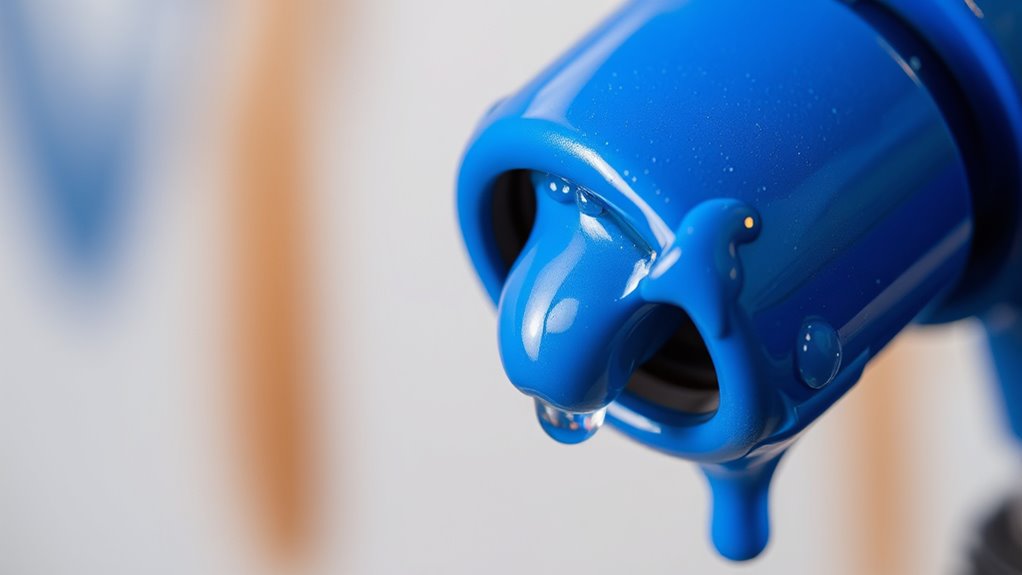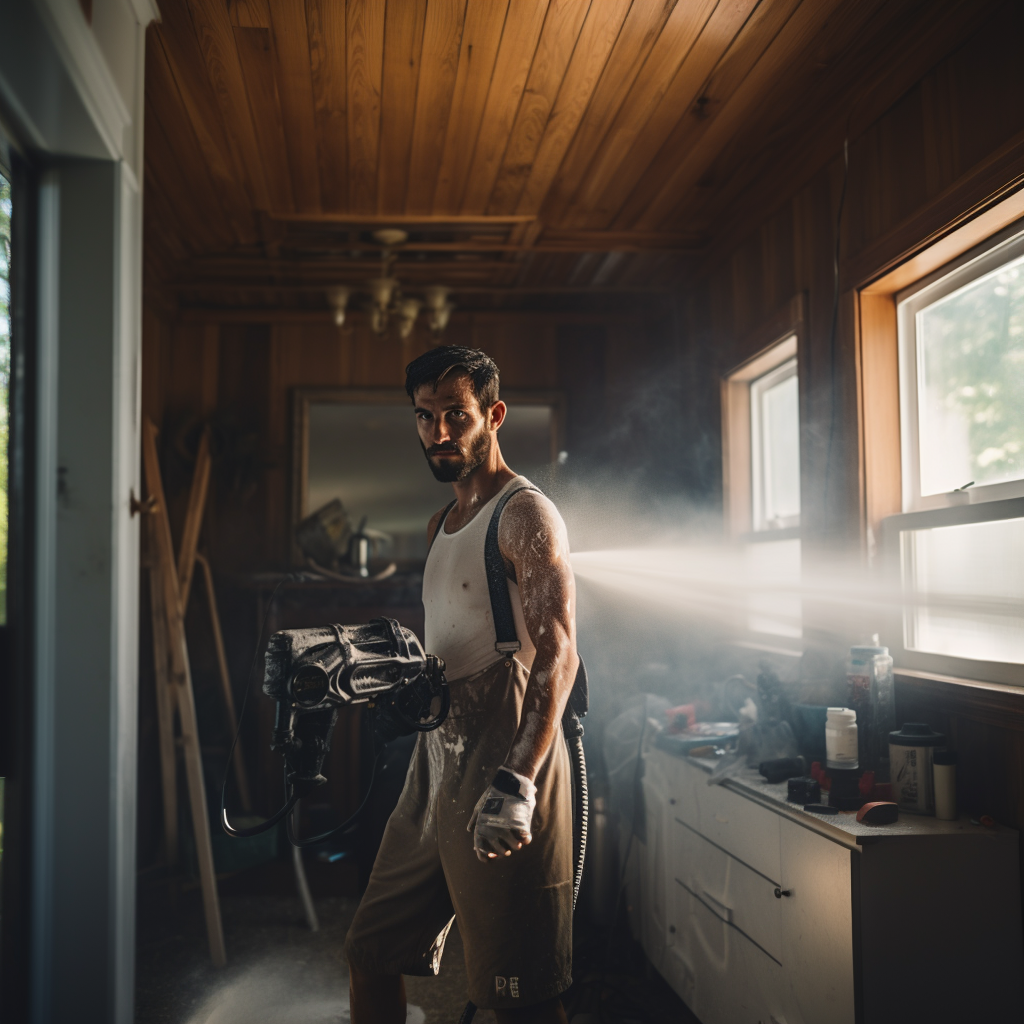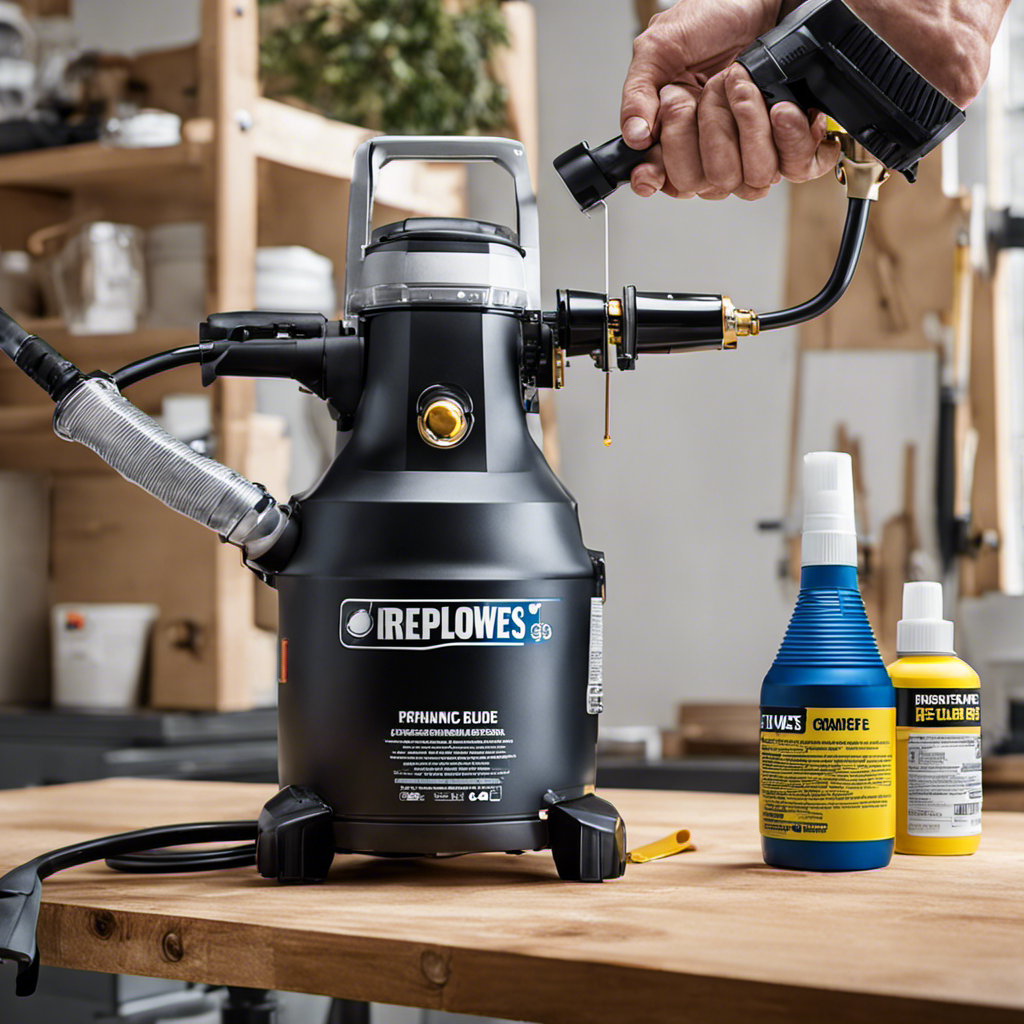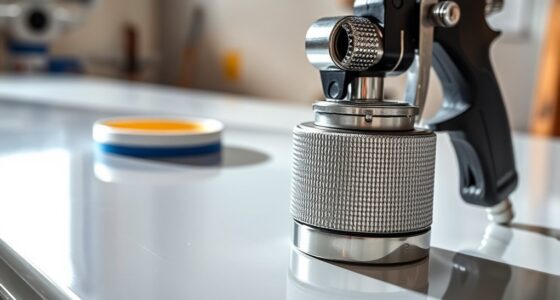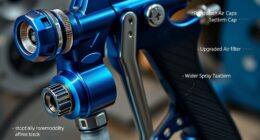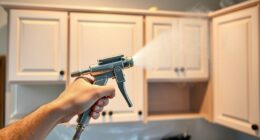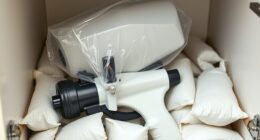You can typically leave water-based paints in a sprayer for up to 24 hours if you follow proper storage steps like sealing the container and covering the nozzle. Oil-based paints tend to clog or harden much sooner without a thorough cleaning. To avoid issues, clean and seal your sprayer after each use and check for signs like clogs or uneven spray. For more tips on maintaining your equipment and extending paint usability, keep exploring this guide.
Key Takeaways
- Short-term storage (up to 24 hours) is generally safe if the sprayer is properly cleaned and sealed.
- Water-based paints can often be left in the sprayer briefly with minimal issues.
- Oil-based paints tend to thicken or clog if left in the sprayer for extended periods.
- Always rinse and seal the reservoir to prevent paint from drying or causing clogs.
- Long-term storage increases risks of clogging, separation, and equipment damage, so cleaning is essential.
Factors That Affect Paint Longevity in a Sprayer
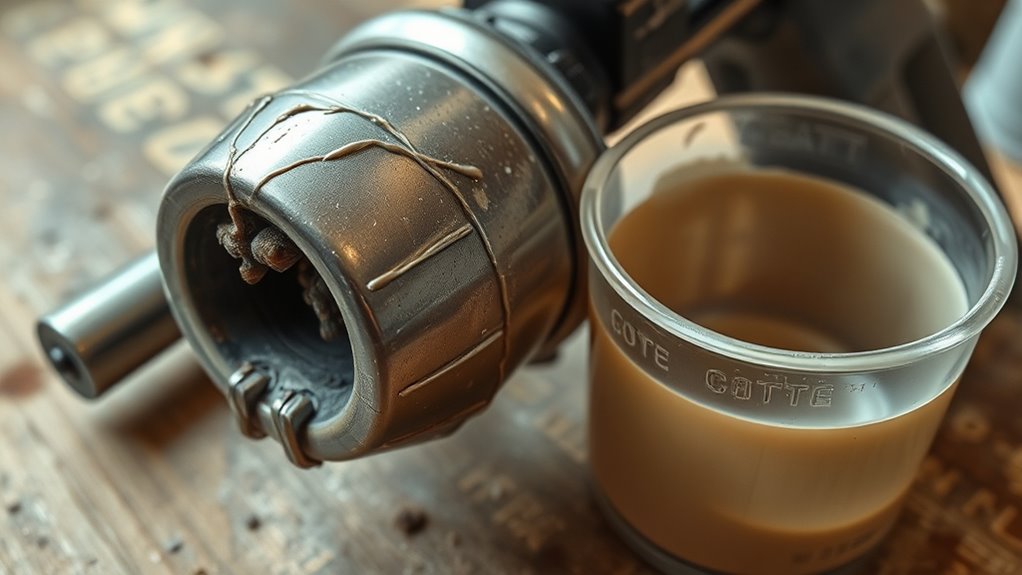
Several factors can influence how long paint remains usable in a sprayer. One key factor is paint viscosity; if the paint is too thick or too thin, it can clog the sprayer or affect spray quality. You’ll want to verify the paint’s viscosity matches the sprayer’s specifications for ideal performance. Compatibility also plays a significant role—using paint formulas that aren’t suited for your sprayer can cause issues such as clogging or uneven application. Check your sprayer’s manual to see which types of paint are recommended. Additionally, if the paint is mixed improperly or contains contaminants, it may degrade faster. Ensuring proper paint preparation and maintaining the correct paint consistency helps you maintain sprayer functionality and ensures your projects turn out smooth and professional. Regular cleaning and proper storage of unused paint can also extend its usability in the sprayer, preventing issues related to contamination or drying. Proper storage conditions can prevent the paint from drying out or separating, which can significantly reduce its lifespan in the sprayer.
Optimal Time Frames for Leaving Paint in a Sprayer
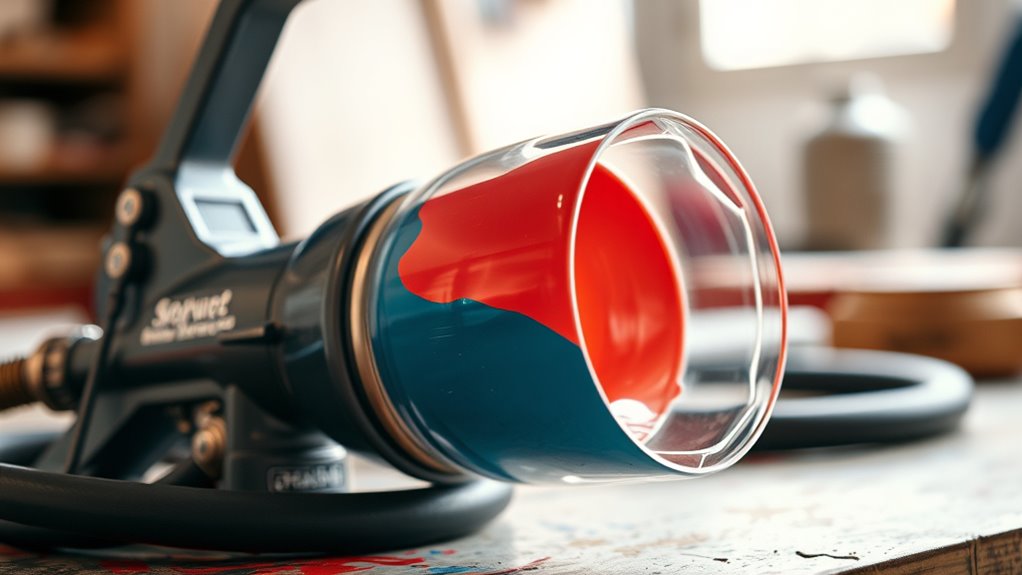
You need to know the best time frames for leaving paint in your sprayer to prevent issues. Short-term storage is usually safe if you follow proper procedures, but keeping paint in the sprayer too long can cause drying or clogging. Proper cleaning after use is essential to prevent problems and ensure your sprayer stays in good condition. Using the right exfoliation techniques can help maintain the sprayer’s performance over time. Additionally, understanding digital literacy can help you access tutorials and resources for proper cleaning techniques and maintenance tips. Being aware of projector technology, such as contrast ratios and color accuracy, can also assist if you decide to upgrade your tools for future projects. Moreover, knowing the maintenance and troubleshooting tips can prevent costly repairs and extend the lifespan of your equipment.
Short-term Storage Guidelines
If you plan to pause your painting project temporarily, it’s important to know how long you can leave paint in your sprayer without compromising its quality. Typically, for short-term storage—up to 24 hours—it’s best to consider paint compatibility and sprayer types. Water-based paints usually require minimal cleanup, making them suitable for brief pauses, but oil-based paints may thicken or clog the system. Always check your sprayer’s manufacturer’s instructions to guarantee it can handle the intended paint type during short-term storage. Rinsing and properly sealing the paint reservoir can help prevent drying or clogs. Remember, even short pauses can impact paint consistency if not stored correctly, so always take precautions to maintain ideal performance for your next painting session. Additionally, understanding paint formulation can help you better determine the appropriate storage methods and durations for your sprayer. Proper storage techniques are essential for preserving the paint’s quality and ensuring smooth application later. Using airtight containers can further prevent contamination and drying out during short-term pauses. Incorporating proper maintenance routines between uses can extend the lifespan of your sprayer and improve overall performance.
Risks of Long-term Storage
Leaving paint in your sprayer for an extended period can lead to significant issues, as the risks increase with time. Overly long storage can cause clogging, paint separation, and damage to your equipment. The paint’s compatibility with your sprayer type is essential; incompatible paints may deteriorate faster. Additionally, the longer paint sits, the higher the chance of drying or hardening inside the nozzle and lines, making cleaning more difficult. Proper cleaning and maintenance are vital to prevent damage to seals and internal parts, and storing paint correctly can help mitigate these risks. Using the right storage container materials can also prevent chemical reactions that might compromise the paint’s quality over time. Furthermore, paint formulation plays a crucial role in how well it can be stored and maintained for future use. It’s also important to consider chemical stability to ensure the paint remains usable over the recommended storage period. Being aware of storage duration recommendations can help you decide the optimal time frame to avoid problems.
Proper Cleaning Procedures
Proper cleaning is essential to maintain your sprayer’s performance and prevent costly damage. After each use, thoroughly flush the equipment with the appropriate solvent based on your paint color and type. Ensuring compatibility between the cleaning solution and your sprayer prevents corrosion or damage. Pay close attention to the paint’s consistency and the equipment’s recommended cleaning procedures, as some materials require specific solvents or brushes. If you leave paint in the sprayer for too long without cleaning, it can harden and clog the system, making future cleanup more difficult. Always clean your sprayer promptly after finishing, especially if you plan to switch colors or types. Proper cleaning not only preserves equipment compatibility but also extends the lifespan of your sprayer and maintains ideal spray performance.
How to Prevent Paint Drying or Clogging in Your Equipment

To keep your sprayer working smoothly, you need to focus on proper storage techniques and maintenance. Using retaining agents can help prevent paint from drying out and clogging your equipment. Regularly cleaning and inspecting your sprayer guarantees it stays in top condition for your next project. Additionally, practicing home cleaning tips and maintenance can help extend the lifespan of your tools and ensure optimal performance. Incorporating protective storage practices can further prevent paint from drying or solidifying inside the sprayer components, reducing the risk of clogs and ensuring readiness for future use. Proper air quality management within your workspace can also minimize the accumulation of dust and debris that might cause blockages. Understanding emergency preparedness essentials can help you maintain your equipment during unexpected disruptions, ensuring your tools are always ready when needed. Moreover, being aware of relationship dynamics can help you better manage commitments and avoid stress that might impact your project schedule.
Proper Storage Techniques
When storing your paint sprayer, ensuring the paint doesn’t dry out or clog the equipment is essential for maintaining its performance. Proper storage extends the paint’s shelf life and prevents costly repairs. Follow these tips:
- Use airtight storage containers to keep paint fresh and prevent drying.
- Clean the sprayer thoroughly before storage to remove residual paint.
- Cover the nozzle and hoses with plastic or caps to avoid dust and debris.
- Store your equipment in a cool, dry place away from direct sunlight to prevent paint from hardening inside the system.
- Regularly check and replace filters to ensure optimal airflow and prevent clogs HEPA filtration. These techniques help keep your sprayer ready for use, reduce clogging risks, and maintain ideal performance over time. Proper storage is key to extending the life of both your paint and equipment.
Use of Retaining Agents
Using retaining agents in your paint helps prevent it from drying out or clogging your equipment during storage or pauses in work. These agents work by maintaining the paint’s moisture and consistency, which is essential for effective paint preservation. When added properly, retaining agents create a barrier that slows down the drying process, reducing the risk of buildup inside your sprayer. This means you can leave paint in your equipment longer without worrying about clogs or compromised quality. Be sure to follow the manufacturer’s instructions for the correct amount of retaining agents to use. Incorporating these additives into your paint routine ensures smoother application and easier cleanup, ultimately saving you time and effort when working on your project.
Regular Equipment Maintenance
Regular equipment maintenance is essential for preventing paint from drying or clogging your sprayer. Proper upkeep ensures your sprayer capacity is used efficiently and the correct paint color is maintained during your project. To keep your equipment in top shape, follow these steps:
- Clean the spray gun thoroughly after each use, especially when switching paint colors.
- Flush the hoses with water or solvent to prevent residual paint from drying inside.
- Check and replace worn seals or filters regularly to avoid clogs.
- Store the sprayer in a clean, dry place, and run a solvent through it if you’re taking a break for an extended period.
Consistent maintenance minimizes drying and clogging, saving you time and effort during your painting project.
Tips for Cleaning and Maintaining Your Paint Sprayer
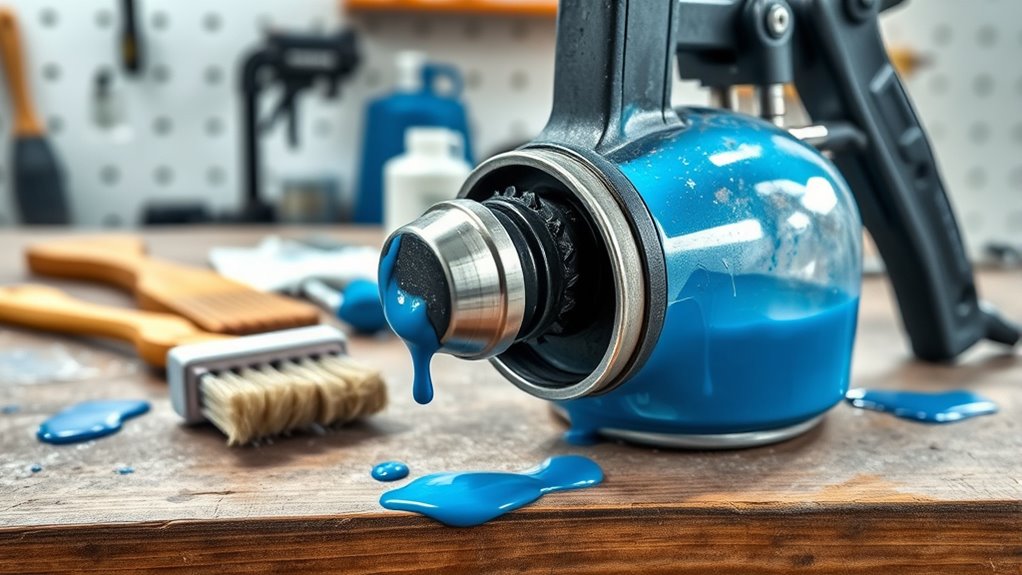
Proper cleaning and maintenance are essential to keep your paint sprayer functioning efficiently and prolong its lifespan. After each use, flush out leftover paint thoroughly to prevent clogging. When cleaning, pay attention to the paint mixing chamber and nozzle, ensuring they’re free of dried paint that can hinder color matching and spray quality. Regularly inspect seals and filters, replacing them if needed. Use appropriate cleaning solutions for the paint type you used. To keep your sprayer in top shape, create a maintenance routine that includes cleaning after every project and periodic deep cleans.
| Tip | Benefit |
|---|---|
| Clean immediately | Prevents stubborn buildup |
| Use proper solutions | Protects internal parts |
| Check seals regularly | Ensures consistent spray |
| Store properly | Extends lifespan |
Signs That Indicate It’s Time to Clean or Refill

You’ll know it’s time to clean or refill your paint sprayer when you notice uneven spray patterns or inconsistent paint flow. These issues often signal that your sprayer needs attention.
- The spray pattern becomes patchy or uneven, affecting your paint color application.
- You see clogs or sputtering, indicating paint buildup or dried material inside the sprayer.
- The paint flow slows down or stops unexpectedly, which might involve residue from the sprayer brand’s design.
- You notice paint dripping or splattering outside the intended area, showing that maintenance is overdue.
Addressing these signs promptly helps keep your sprayer in top condition, ensuring even coverage and consistent results every time you work on your project.
Best Practices for Long Breaks During Painting Projects

When taking an extended break from painting, it’s essential to safeguard your work and equipment to guarantee a smooth restart. First, check your paint compatibility to ensure it won’t spoil or separate during the break. Some paints, like oil-based, may need special handling. Also, consider your sprayer types; different sprayers require specific maintenance. For example, gravity-fed sprayers might need flushing, while airless sprayers often need cleaning and proper sealing. Cover the nozzle or tip to prevent dust and debris from contaminating the paint. Store your sprayer in a protected area, and if possible, use a sprayer cover or plastic wrap to keep it airtight. Following these best practices helps maintain your equipment’s condition and ensures consistent results when you resume your project.
Frequently Asked Questions
Can Leaving Paint in a Sprayer Damage the Equipment Permanently?
Leaving paint in your sprayer can cause damage over time. If you don’t clean it properly, paint can clog the nozzles, making future use difficult. Additionally, some paints can cause equipment corrosion, especially if left for too long. This corrosion can lead to permanent damage, reducing your sprayer’s lifespan. To avoid these issues, always clean your sprayer thoroughly after use, especially if you plan to store it for a while.
Does the Type of Paint Affect How Long It Can Stay in a Sprayer?
The type of paint considerably impacts how long you can leave it in your sprayer. Paint type, especially its chemical composition, determines its stability and risk of clogging or drying out. Water-based paints usually last longer in the sprayer than oil-based ones, which can thicken or harden quickly. Always consider the chemical makeup and manufacturer’s recommendations to prevent equipment damage and guarantee peak performance during your project.
Are There Specific Storage Conditions to Prolong Paint Life in a Sprayer?
Imagine a cozy, airtight container protecting your paint like a treasure chest. Proper storage techniques are key to paint preservation in your sprayer. Keep the sprayer in a cool, dry place, away from direct sunlight and temperature fluctuations. Rinse and clean the equipment thoroughly after each use. These steps prevent paint from drying out or clogging, ensuring your paint stays fresh and ready for your next project.
What Are the Risks of Leaving Paint in a Sprayer Overnight?
Leaving paint in a sprayer overnight risks paint clogging and separation, which can make cleaning difficult and affect your project’s finish. Over time, paint inside the sprayer can dry, causing blockages and uneven spray patterns. To avoid these issues, it’s best to clean your sprayer thoroughly after each use or store it with appropriate additives to prevent paint from drying or separating. This keeps your equipment ready for next time.
How Does Climate or Humidity Influence Paint Preservation in a Sprayer?
Climate effects and humidity impact how well paint stays in your sprayer. High humidity can cause the paint to thicken or develop mold, making it harder to spray later. Cold temperatures may cause the paint to harden or separate, while hot, dry conditions can lead to quicker drying inside the nozzle. To preserve your paint, store your sprayer in a cool, dry place and consider adding a retarder or stabilizer if needed.
Conclusion
Remember, leaving paint in your sprayer is like trapping a fleeting sunset—if you wait too long, the vibrant colors fade and become impossible to revive. To keep your equipment in top shape, clean it thoroughly after each use and avoid prolonged storage. With proper care, your sprayer will remain a reliable tool, ready to bring your creative visions to life whenever inspiration strikes, just like a well-preserved sunset waiting to be painted anew.
Franz came aboard the Paint Sprayer Zone team with a background in both journalism and home renovation. His articulate writing style, combined with a passion for DIY projects, makes him an invaluable asset. Franz has a knack for breaking down technical jargon into easy-to-understand content, ensuring that even the most novice of readers can grasp the complexities of paint sprayers.
